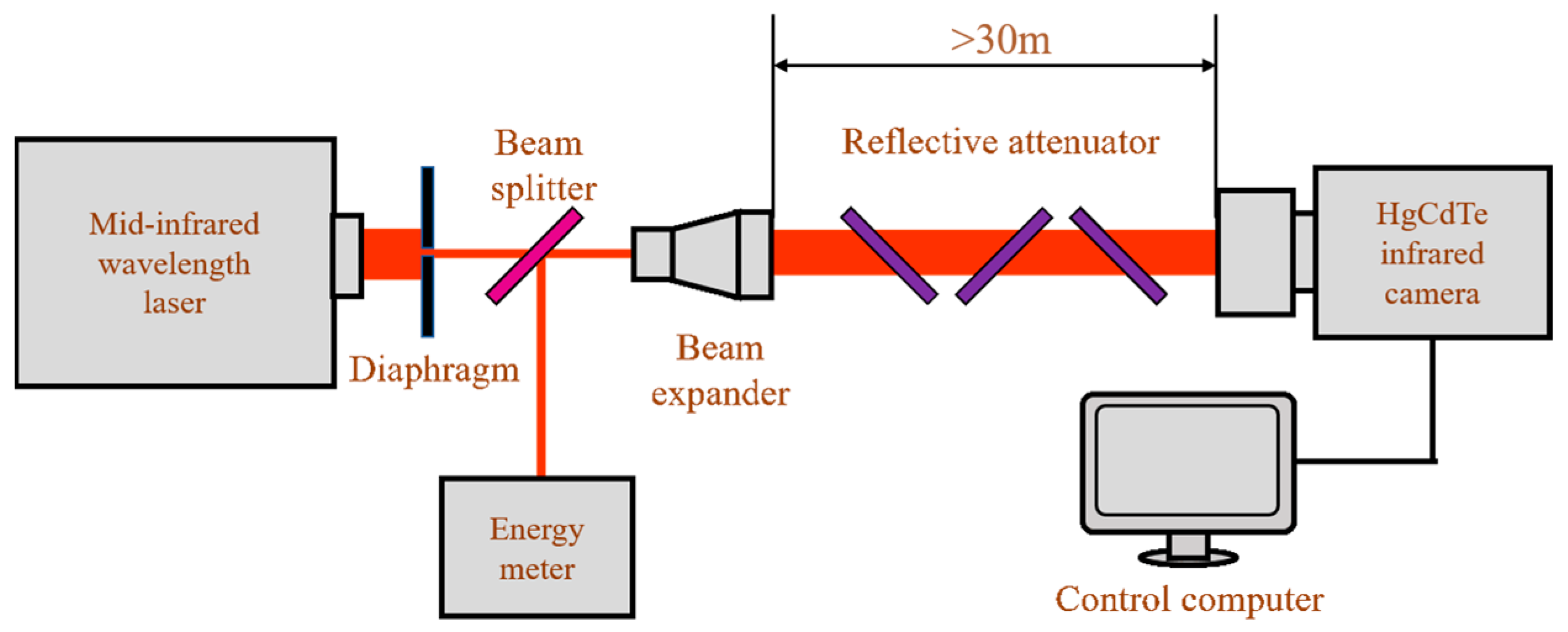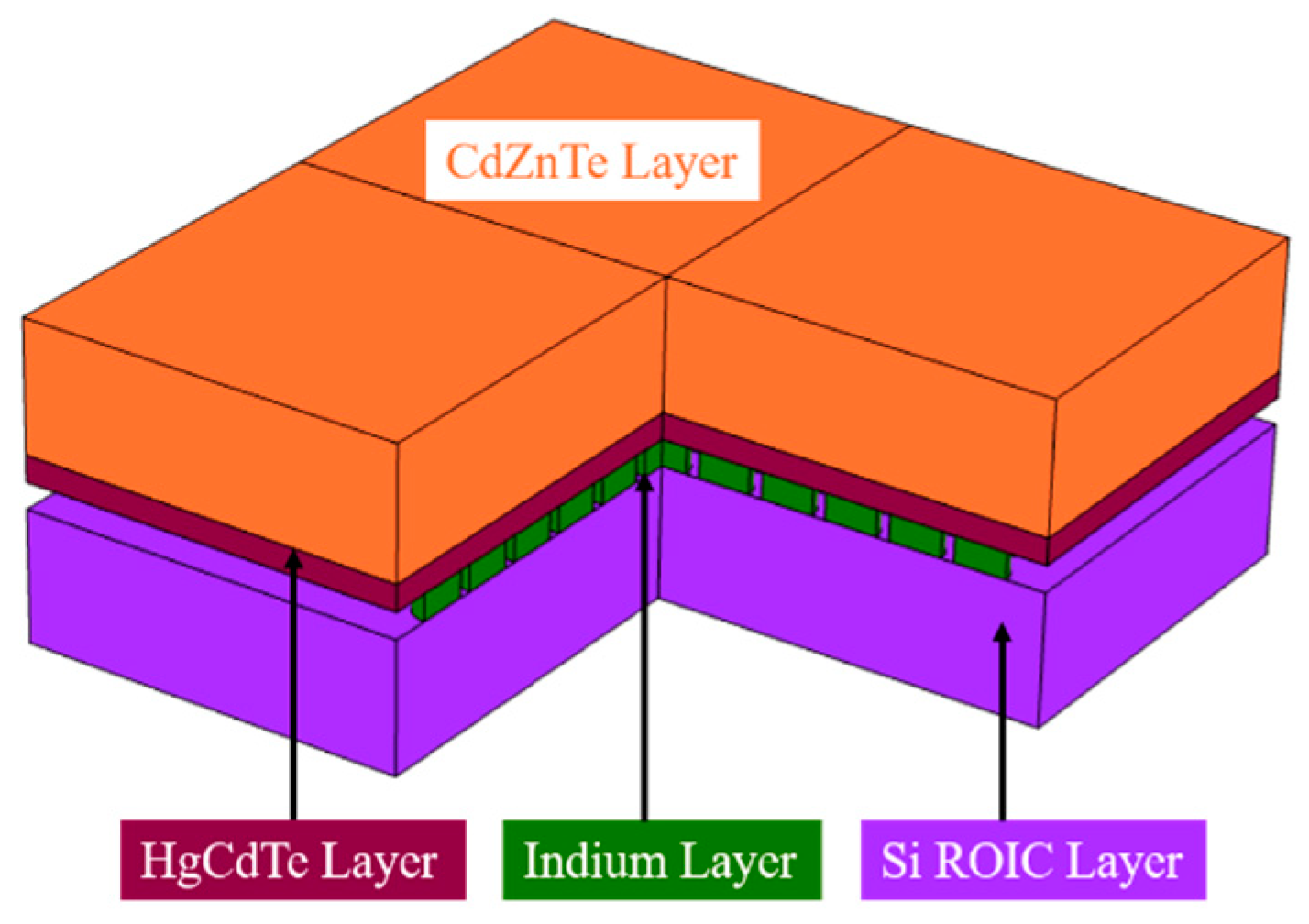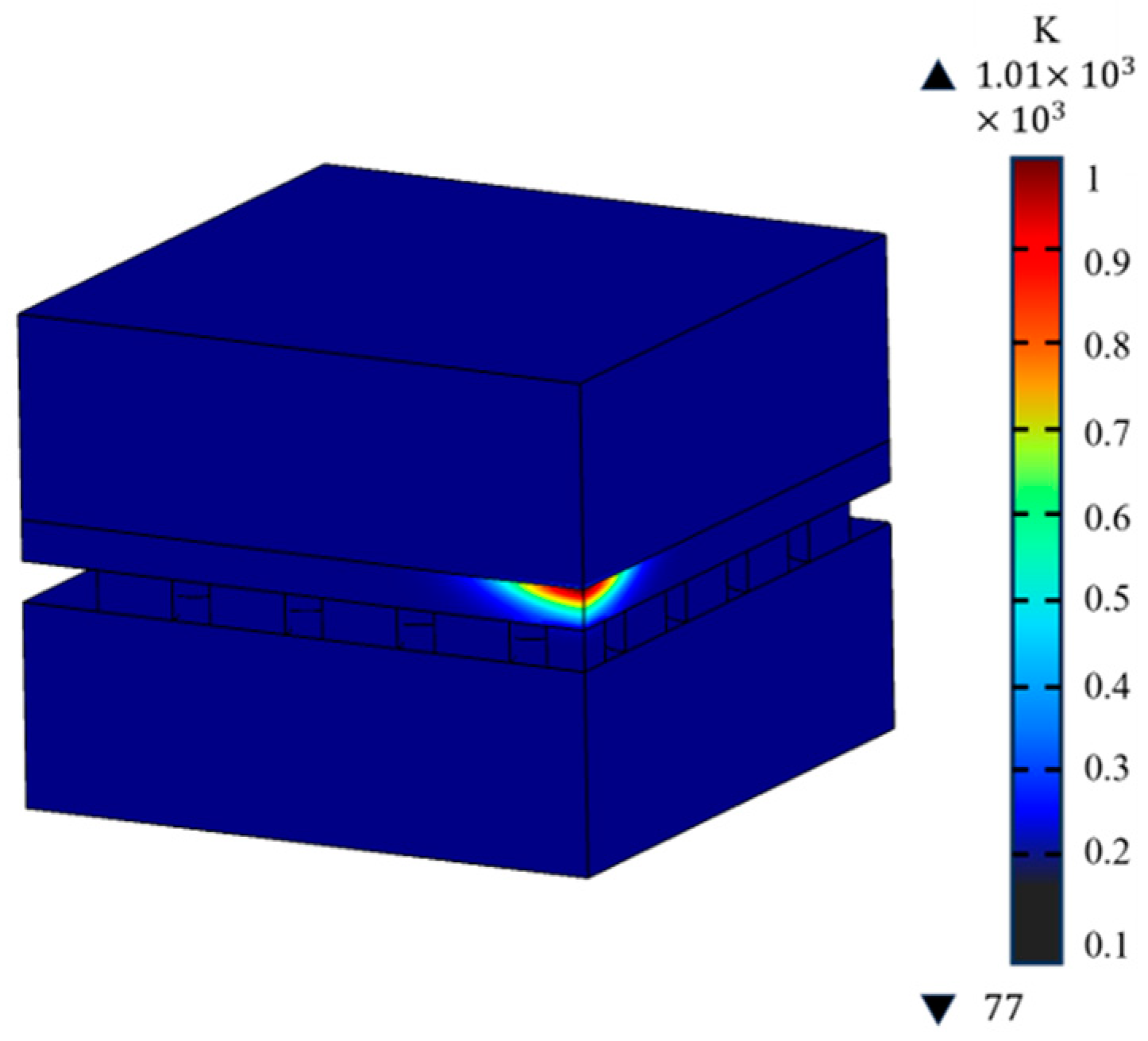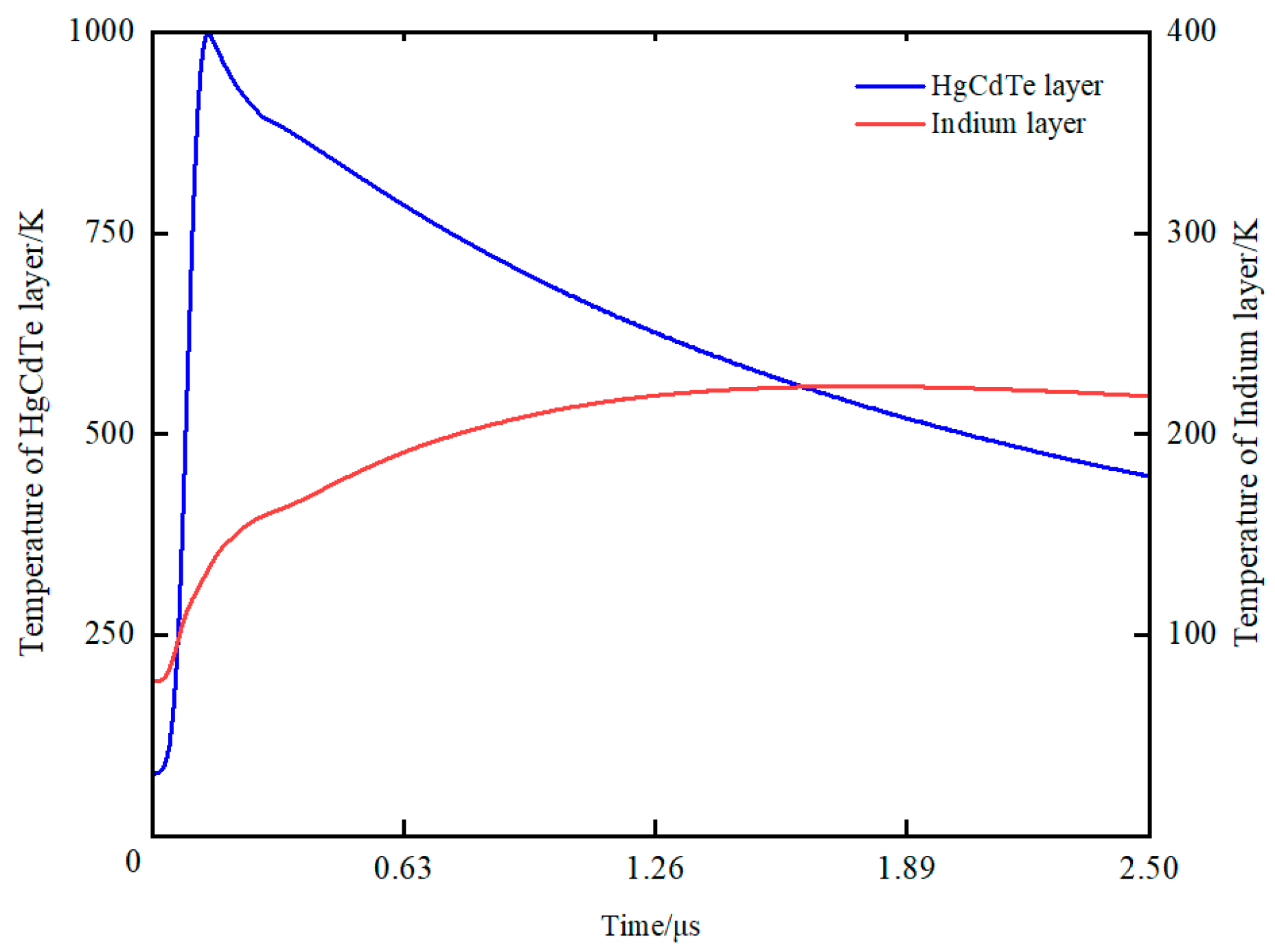Damage Mechanism of HgCdTe Focal Plane Array Detector Irradiated Using Mid-Infrared Pulse Laser
Abstract
:1. Introduction
- Research subjects include mostly Hg1−xCdxTe crystal and PV-type or PC-type HgCdTe detectors with working wavelengths located in LWIR. The laser wavelengths used in damage experiments are mostly 10.6 μm or 9.3 μm.
- Research directions mainly include detector response rate, damage threshold, and damage morphology analysis.
- In theoretical research, one-dimensional or two-dimensional models are often constructed based on the structure of PV- or PC-type detectors.
2. Materials and Methods
2.1. Experimental Setup
2.2. Theoretical Model
2.2.1. Model Structure
- Layers that are relatively thin, such as the connect metal layer, the passivation layer, and the insulation layer, are ignored. The thickness of these layers is less than one-tenth of that of the photosensitive layer. Ignoring them does not have a negative impact on the calculation results but instead helps reduce the difficulty of mesh generation and improves the mesh quality.
- The thicknesses of the Si readout circuit layer and the CdZnTe layer are reduced. The Si layer is directly connected to the refrigeration module, and its temperature can always be considered 77 K. It is also reasonable to decrease the thickness of the CdZnTe layer due to its high transmissivity to the response wave band. The absorption and reflection occurring in the CdZnTe layer are ignored.
- Inter-layer absorption and reflection re disregarded. It is though that the laser directly reaches the HgCdTe layer through the substrate layer.
- Unlike previous models that chose material physical parameters as a constant, the core parameters of this model are set as functions of temperature, such as absorption coefficient, thermal conductivity, and heat capacity.
- All layers are regarded as isotropic crystals.
2.2.2. Physical Equation
2.2.3. Material Physical Parameters
3. Results
3.1. Experimental Results
3.2. Simulation Results
3.2.1. Heat Transfer Mechanism
3.2.2. Displacement Deformation and Stress
3.2.3. Damage Order and Threshold
3.2.4. Effect of Pulse Width on Threshold
4. Discussion
- The actual detector structure is much more intricate than the theoretical model, necessitating simplification of the model. The calculation accuracy, ability, and model matching degree must be balanced to ensure minimal deviation in the results.
- The loading method of light source differs from the actual situation. In practice, the laser irradiates the detector surface through a lens, which introduces additional factors such as lens transmissivity and detector reflection. These factors are not considered in the theoretical model, leading to a higher measured energy before the lens than the energy absorbed by the detector. Consequently, the experimental damage threshold E0 is expected to be higher than the theoretical damage threshold Ec.
- There may be discrepancies in the physical parameters of materials that cannot be accounted for in the theoretical model.
5. Conclusions
Author Contributions
Funding
Institutional Review Board Statement
Informed Consent Statement
Data Availability Statement
Acknowledgments
Conflicts of Interest
References
- Lawson, W.D.; Nielsen, S.; Putley, E.H.; Young, A.S. Preparation and Properties of HgTe and Mixed Crystals of HgTe-CdTe. J. Phys. Chem. Solids 1959, 9, 325–329. [Google Scholar] [CrossRef]
- Kopytko, M.; Sobieski, J.; Gawron, W.; Martyniuk, P. Study of HgCdTe (100) and HgCdTe (111)B Heterostructures Grown by MOCVD and Their Potential Application to APDs Operating in the IR Range up to 8 μm. Sensors 2022, 22, 924. [Google Scholar] [CrossRef]
- Rogalski, A.; Antoszewski, J.; Faraone, L. Third-generation Infrared Photodetector Arrays. J. Appl. Phys. 2009, 105, 091101. [Google Scholar] [CrossRef]
- Gravrand, O.; Baier, N.; Ferron, A.; Rochette, F.; Lobre, C.; Bertoz, J.; Rubaldo, L. Discussion Around IR Material and Structure Issues to Go Toward HighPerformance Small Pixel Pitch IR HOT FPAs. Opto-Electron. Rev. 2023, 31, e144561. [Google Scholar] [CrossRef]
- Madejczyk, P.; Manyk, T.; Rutkowski, J. Research on Electro-Optical Characteristics of Infrared Detectors with HgCdTe Operating at Room Temperature. Sensors 2023, 23, 1088. [Google Scholar] [CrossRef]
- Rogalski, A.; Martyniuk, P.; Kopytko, M.; Hu, W. Trends in Performance Limits of the HOT Infrared Photodetectors. Appl. Sci. 2021, 11, 501. [Google Scholar] [CrossRef]
- Eich, D.; Ames, C.; Breiter, R.; Figgemeier, H.; Hanna, S.; Lutz, H.; Mahlein, K.M.; Schallenberg, T.; Sieck, A.; Wenisch, J. MCT-Based High Performance Bispectral Detectors by AIM. J. Electron. Mater. 2019, 48, 6074–6083. [Google Scholar] [CrossRef]
- Figgemeier, H.; Hanna, S.; Eich, D.; Fries, P.; Mahlein, K.M.; Wenisch, J.; Schirmacher, W.; Beetz, J.; Breiter, R. State-of-the-Art MCT Photodiodes for Cutting-Edge Sensor Applications by AIM. In Proceedings of the Conference on Infrared Technology and Applications XLIII, Anaheim, CA, USA, 9–13 April 2017. [Google Scholar]
- Bartoli, F.; Kruer, M.; Esterowitz, L.; Allen, R. Laser Damage in Triglycine Sulfate—Experimental Results and Thermal-Analysis. J. Appl. Phys. 1973, 44, 3713–3720. [Google Scholar] [CrossRef]
- Bartoli, F.; Esterowitz, L.; Kruer, M.; Allen, R. Thermal Modeling of Laser Damage In 8-14 μm HgCdTe Photoconductive and Pbsnte Photovoltaic Detectors. J. Appl. Phys. 1975, 46, 4519–4525. [Google Scholar] [CrossRef]
- Arora, V.K.; Dawar, A.L. Effect of Laser Irradiation on the Responsivity of Mercury Cadmium Telluride Detectors. Infrared Phys. Technol. 1996, 37, 245–249. [Google Scholar] [CrossRef]
- Zhao, J.H.; Li, X.Y.; Liu, H.; Jiang, R.Q.; Liu, Z.P.; Hu, Z.H.; Gong, H.M.; Fang, J.X. Damage Threshold of HgCdTe Induced by Continuous-wave CO2 laser. Appl. Phys. Lett. 1999, 74, 1081–1083. [Google Scholar] [CrossRef]
- Cai, H.; Cheng, Z.H.; Zhu, H.H.; Zuo, D.L. Fracture Mechanisms of Hg0.8Cd0.2Te Induced by Pulsed TEA-CO2 Laser. Appl. Surf. Sci. 2005, 252, 1685–1692. [Google Scholar] [CrossRef]
- Tang, W.; Guo, J.; Shao, J.; Wang, T. Analysis of Damage Threshold on HgCdTe Crystal Irradiated by Multi-pulsed CO2 Laser. Opt. Laser Technol. 2014, 58, 172–176. [Google Scholar] [CrossRef]
- Chen, C.S.; Liu, A.H.; Sun, G.; He, J.L.; Wei, X.Q.; Liu, M.; Zhang, Z.G.; Man, B.Y. Analysis of Laser Damage Threshold and Morphological Changes at the Surface of a HgCdTe Crystal. J. Opt. A-Pure Appl. Opt. 2006, 8, 88–92. [Google Scholar] [CrossRef]
- Jia, X.S.; Chen, Y.Q.; Liu, L.; Wang, C.; Duan, J.A. Combined pulse laser: Reliable tool for high-quality, high-efficiency material processing. Opt. Laser Technol. 2022, 153, 21. [Google Scholar] [CrossRef]
- Jia, X.S.; Chen, Y.Q.; Liu, L.; Wang, C.; Duan, J.A. Advances in Laser Drilling of Structural Ceramics. Nanomaterials 2022, 12, 39. [Google Scholar] [CrossRef]
- Patten, E.A.; Goetz, P.M.; Vilela, M.F.; Olsson, K.; Lofgreen, D.D.; Vodicka, J.G.; Johnson, S.M. High-Performance MWIR/LWIR Dual-Band 640 × 480 HgCdTe/Si FPAs. J. Electron. Mater. 2010, 39, 2215–2219. [Google Scholar] [CrossRef]
- Chu, J.; Xu, S.; Tang, D. Energy gap versus alloy composition and temperature in Hg1−xCdxTe. Appl. Phys. Lett. 1983, 43, 1064–1066. [Google Scholar] [CrossRef]
- Krishnamurthy, S.; Yu, Z.G.; Gonzalez, L.P.; Guha, S. Accurate Evaluation of Nonlinear Absorption Coefficients in InAs, InSb, and HgCdTe Alloys. J. Appl. Phys. 2007, 101, 113104. [Google Scholar] [CrossRef]
- Chu, J.-H.; Mi, Z.-Y.; Tang, D.-Y. Band-to-band optical absorption in narrow-gap Hg1−xCdxTe semiconductors. J. Appl. Phys. 1992, 71, 3955–3961. [Google Scholar] [CrossRef]
- Capper, P. Properties of Narrow-Gap Cadmium-Based Compounds. Optoelectron. IEEE Proc. 1994, 142, 315. [Google Scholar] [CrossRef]
- Zhang, Y.; Shao, J.; Tang, W. Damage effect of TEA CO2 long wave infrared laser on detector assembly of infrared staring imaging system. Opt. Precis. Eng. 2021, 29, 1217–1224. [Google Scholar] [CrossRef]










| Physical Parameter | CdZnTe | HgCdTe | Indium | Si |
|---|---|---|---|---|
| Density (gcm−3) | 5.68 | 7.64 | 7.3 | 2.33 |
| Specific heat (Jg−1K−1) | 0.159 | 0.233 | 0.7 | |
| Thermal conductivity k (Wcm−1K−1) | 0.01 | 0.82 | 1.3 | |
| Coefficient of thermal expansion β (K−1) | 5 × 10−6 | 5 × 10−6 | 3.3 × 10−5 | 1.15 × 10−6 |
| melting point (K) | 1460 | 993 | 426 | 1410 |
| Elastic module E (Pa) | 3.98 × 1011 | 5 × 1010 | 1.06 × 1010 | 1.3 × 1011 |
| Poisson’s ratio | 0.459 | 0.31 | 0.45 | 0.24 |
Disclaimer/Publisher’s Note: The statements, opinions and data contained in all publications are solely those of the individual author(s) and contributor(s) and not of MDPI and/or the editor(s). MDPI and/or the editor(s) disclaim responsibility for any injury to people or property resulting from any ideas, methods, instructions or products referred to in the content. |
© 2023 by the authors. Licensee MDPI, Basel, Switzerland. This article is an open access article distributed under the terms and conditions of the Creative Commons Attribution (CC BY) license (https://creativecommons.org/licenses/by/4.0/).
Share and Cite
Zhang, Y.; Zheng, C.; Liu, Y.; Wang, Y.; Xu, Y.; Shao, J. Damage Mechanism of HgCdTe Focal Plane Array Detector Irradiated Using Mid-Infrared Pulse Laser. Sensors 2023, 23, 9370. https://doi.org/10.3390/s23239370
Zhang Y, Zheng C, Liu Y, Wang Y, Xu Y, Shao J. Damage Mechanism of HgCdTe Focal Plane Array Detector Irradiated Using Mid-Infrared Pulse Laser. Sensors. 2023; 23(23):9370. https://doi.org/10.3390/s23239370
Chicago/Turabian StyleZhang, Yin, Changbin Zheng, Yang Liu, Yunzhe Wang, Yongbo Xu, and Junfeng Shao. 2023. "Damage Mechanism of HgCdTe Focal Plane Array Detector Irradiated Using Mid-Infrared Pulse Laser" Sensors 23, no. 23: 9370. https://doi.org/10.3390/s23239370
APA StyleZhang, Y., Zheng, C., Liu, Y., Wang, Y., Xu, Y., & Shao, J. (2023). Damage Mechanism of HgCdTe Focal Plane Array Detector Irradiated Using Mid-Infrared Pulse Laser. Sensors, 23(23), 9370. https://doi.org/10.3390/s23239370






